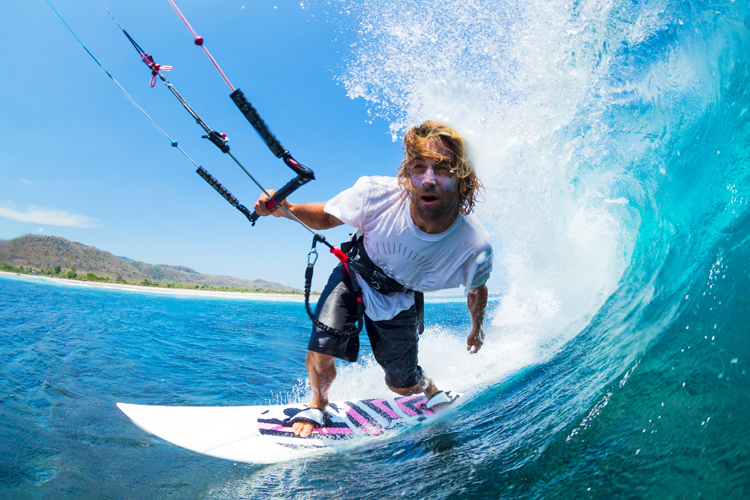Kiteboarding is like wakeboarding with a paraglider; or windsurfing with a short board and a detached sail.
The kite redirects a mass of air each second (m/dt) from the apparent wind-assisted by the Coanda effect at a velocity (dv) relative to the kite, which creates a backward force (Force BACK = ma = m/dt x dv).
This redirected airflow pushes against undisturbed wind behind it, creating turbulence and providing something for the redirected airflow to push against.
The reactive equal and opposite forward force pushes the kite ahead.
The kite pulls the kitesurfer forward (see illustration below).
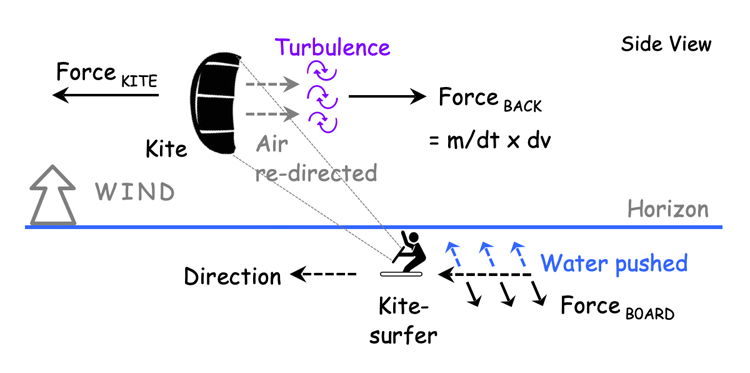
The kiteboarder avoids being blown downwind and maintains line tension by leaning into the wind and pushing water downwind with the board.
The kitesurfer controls the speed and direction of the kite by adjusting its angle-of-attack (AOA).
1. Introduction
Little analysis has been done on the physics of kiteboarding to date.
Much of the available analysis is erroneously based on fluid mechanics (i.e., Bernoulli) and incorrectly compares the forces generated by a kite to the lift generated by an airplane wing.
This paper argues that fluid mechanics explains the airflows that arise, but Newtonian mechanics explains the resultant forces from the airflows.
Applying Newtonian mechanics to explain motion is not a new concept.
However, applying the manner described in this paper to explain kitesurfing based on the mass flow rate is a completely new approach.
The Newtonian analysis presented herein is significant as it provides new and useful insights into kiteboarding.
A better understanding of physics helps kiteboarders become more proficient and helps manufacturers design better equipment.
It provides a simple and easily understood explanation of kitesurfing that is consistent with accepted physics and what is observed in practice.
2. Background - The Basics
A. Kiteboarding Equipment
Kitesurfing is a progressive step in the evolution of sailing as a sport, from sailboats to windsurfers to kiteboarding.
Kitesurfing equipment varies in designs, shapes, and sizes around a basic model.
The equipment includes a distant and detached kite (paraglider) connected by long lines to a kiteboarder by a harness.
The kitesurfer stands on a short board held in place by foot straps (see illustration below).
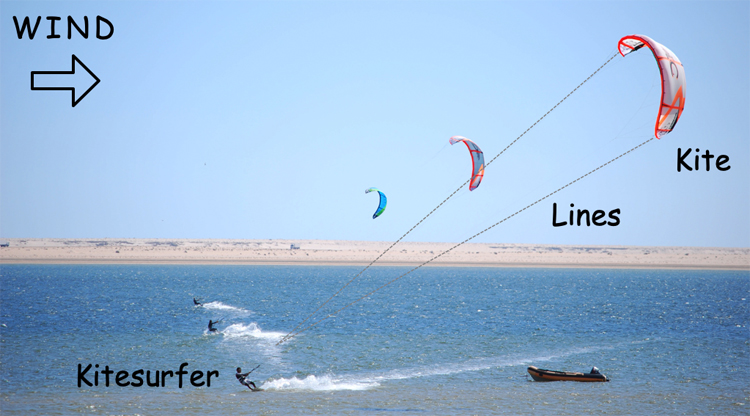
Physically detaching the sail from the boat/board provides mechanical advantages and disadvantages.
One consequence is that the kiteboarder needs to push water downwind in order to avoid being blown downwind or to travel upwind.
In contrast, sailboats and windsurfers do not function like this.
The optimal size of the kite depends on the kitesurfer's weight and ability, as well as wind conditions.
The sport of kiteboarding prioritizes elements such as speed, control, stability, and maneuverability (tricks).
B. A Kite Compared to an Airplane Wing
Efficient kites have similar forms and shapes to airplane wings, with thick leading edges and tapered trailing edges.
The topside is curved (concave), while the underside (inner side) is flat.
This design is aerodynamically efficient as it minimizes drag while also maximizing the airflow redirected and, therefore, the force generated.
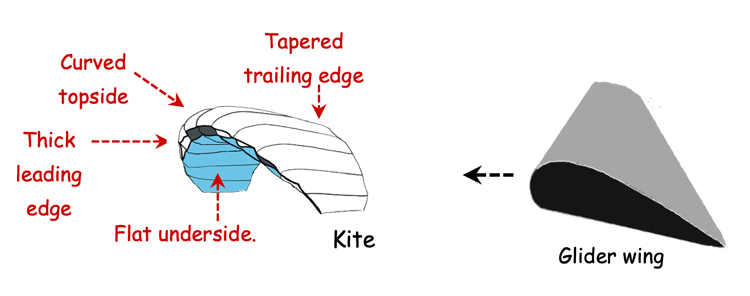
Both kites and airplane wings create forces that can be described by Newtonian mechanics.
However, despite their similar designs, they are applied in different ways. They produce different airflows, and therefore, different forces.
C. The Kite Pulls the Kiteboarder Forward
The kite is the only source of power for the kitesurfer, as it pulls the kitesurfer forward.
This aspect can be confusing because the kite is positioned downwind of the kiteboarder.
However, despite being downwind, the kite is pulling the kitesurfer forward, which is evident from the kite's position in front of the kitesurfer in the direction of travel.
This dynamic is similar to water skiing or wakeboarding alongside a motorboat.
The boat and skier exert forces that push water towards each other to maintain line tension.
The boat and skier are facing each other at slightly oblique angles.
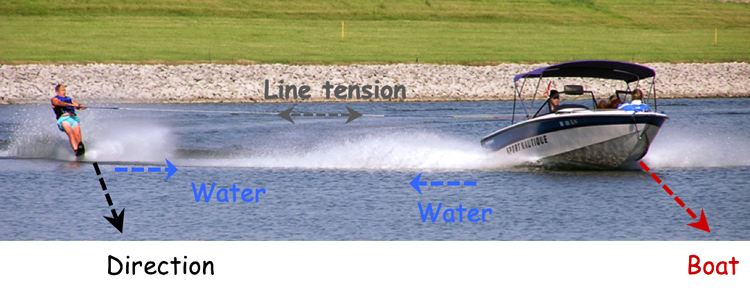
This concept can be demonstrated by replacing the speedboat with a kite in an image of wakeboarding.
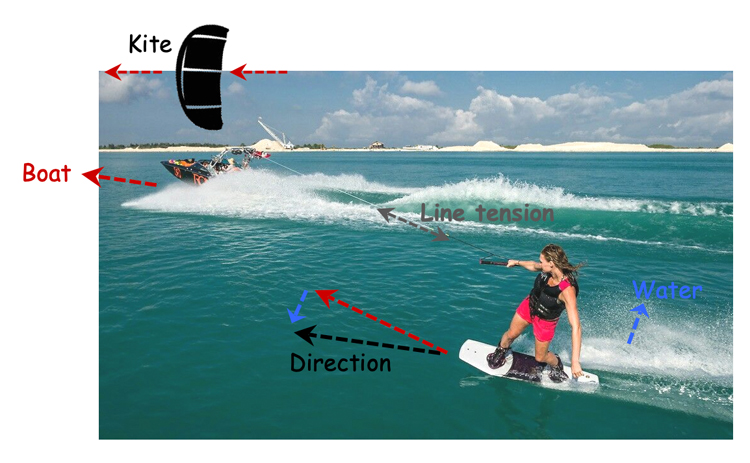
D. Kite AOA
The kite angle-of-attack (AOA) is the angle between the apparent wind (i.e., headwind) and the heading of the kite.
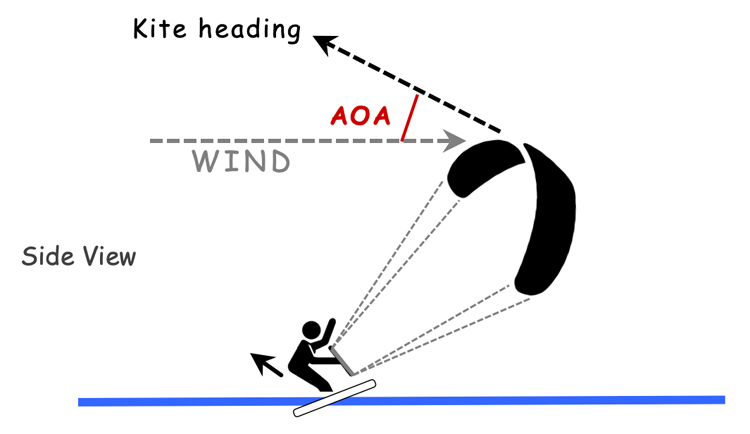
3. Airflow Analysis
A. Two Key Airflows
There are two key airflows that produce two separate forces on a kite, which include (see illustration below):
a) The outer airflow over the outer surface of the kite, which is redirected downwards, helped by the Coanda effect. This generates an equal and opposite upward force;
b) The inner airflow is redirected downwards by the inner surface of the kite. This action also creates a sideways force that pushes the kite downwind at an angle that depends on the kite's AOA. This is the force that the kiteboarder uses to push against the water;
c) The flat undersides of kites are designed to push air down without inducing any Coanda effect;
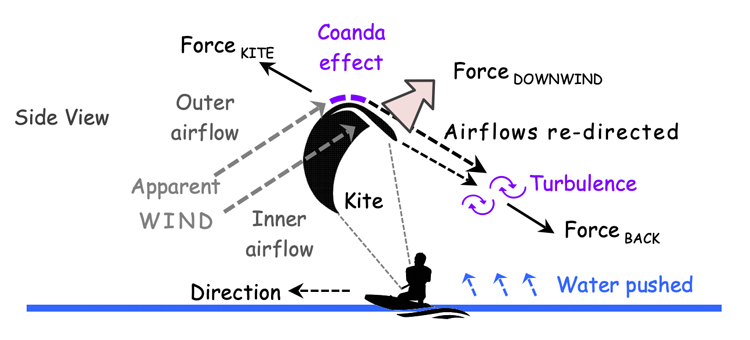
The airflows and forces on the kite from an alternative perspective are illustrated in the illustration below.
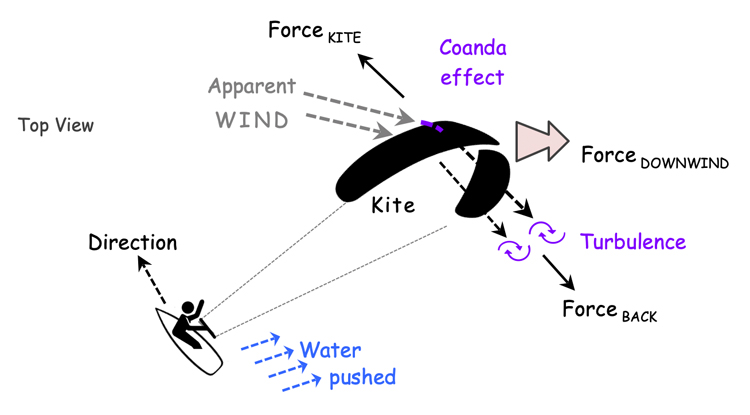
B. The Coanda Effect
Fluid flow naturally follows a curved surface due to the Coanda effect. For example, water falling from a tap is redirected by the curved side of a spoon, as illustrated below.
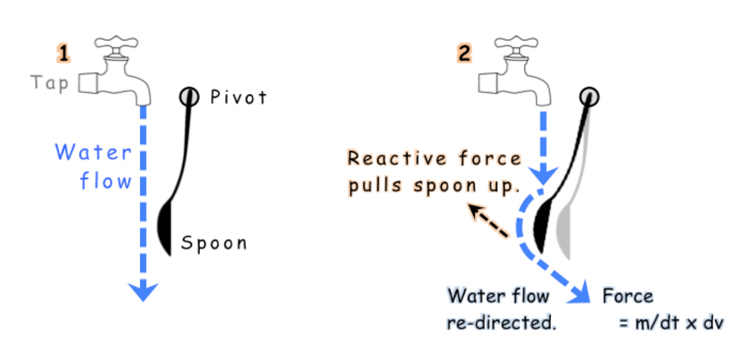
According to Newtonian mechanics, altering the direction of the fluid flow creates a force (Force = ma = m/dt x dv).
The reactive equal and opposite force pushes the spoon diagonally upwards.
The Coanda effect can have a significant effect on fluid flow (m/dt) and, therefore, the generated force.
Similar experiments with curved objects, such as balls and wings, have produced comparable results.
However, researchers made different explanations and conclusions regarding the forces involved.
There is a lack of images available of kites that show the Coanda effect on kites.
Nevertheless, wind tunnel experiments demonstrate airflows arising due to the Coanda effect on a curved airplane wing, as well as the turbulence arising on a flat wing.
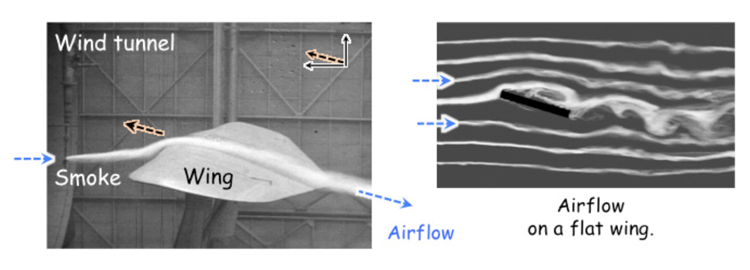
Some fighter jet wing and fuselage designs show pronounced curvature that maximizes the Coanda effect.

C. Coanda Effect on Kites and Sails
The relative airflow from apparent wind follows the curved top side of a kite.
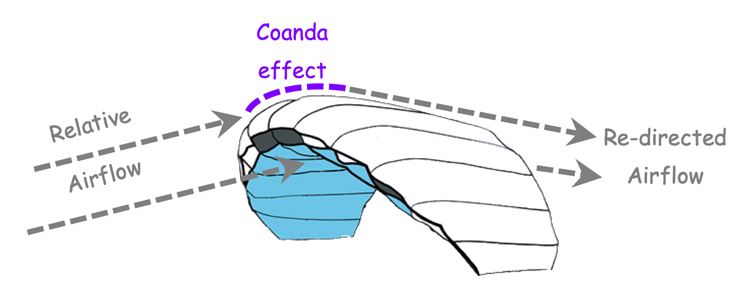
The Coanda effect also redirects airflow on the leeward side of sails.
The airflow around a sail can be illustrated with Computational Fluid Dynamics (CFD).
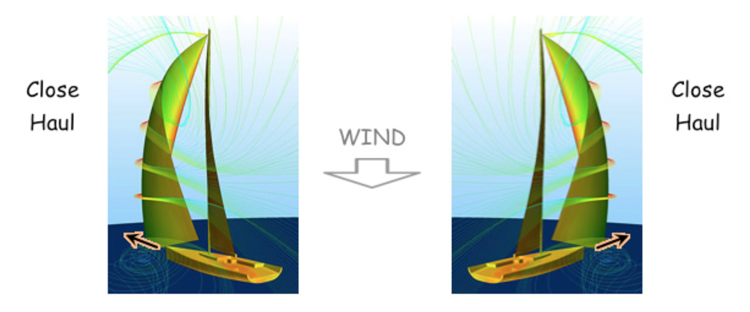
D. Laminar Airflow and Turbulence
The amount of air redirected by the Coanda effect depends on the maintenance of laminar (smooth, non-turbulent) airflow on the topside of the wing to maximize the amount of air displaced down each second (m/dt).
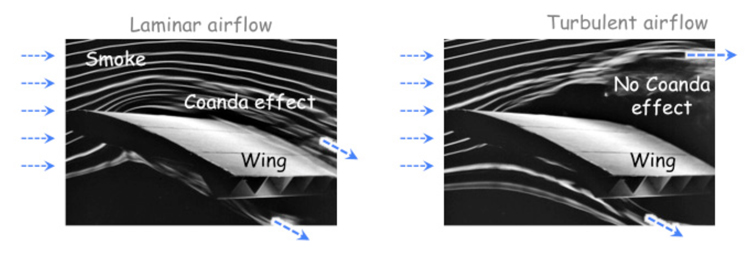
Wings produce a stronger Coanda effect with laminar airflow at a lower AOA, higher airspeed, and where the wings are deepest (largest chord, such as near the fuselage).
Conversely, the Coanda effect is weakest at high AOA, slower airspeeds, and where the wings are narrow (small chord, such as at the wingtips).
The optimum wing AOA maximizes the combined airflow redirected or pushed downwards by the underside and topside of the wing, and therefore, the generated force.
The top airflow is sensitive to changes in wing AOA due to the Coanda effect.
The lower airflow does not rely on the Coanda effect, making it more stable and less sensitive to changes in the wing AOA.
Stalls arising due to disrupted airflow on the topside of wings provide evidence of this difference in airflow sensitivity.
Consequently, attention is focused on the upper airflow when analyzing changes in AOA or other wing characteristics.
The implication is that the top side of the wing can displace a much greater airflow under ideal conditions, as compared to the underside of the wing.
4. Newton Applied to Kiteboarding
A. Newtonian Physics Applied to Kitesurfing
Similar to a sail or a paraglider, a kite redirects airflow to generate a force.
Specifically, the kite redirects a mass of air each second (m/dt) from the apparent wind helped by the Coanda effect, at a velocity (dv) backward relative to the kite.
This redirected airflow pushes against undisturbed, apparent wind behind it, creating turbulence and provides something to push against.
This action generates a backward force (Force = ma = m/dt x dv).
The reactive equal and opposite forward force (Force KITE) pushes the kite ahead.
The kite pulls the kitesurfer forward, which is similar to how a person wakeboarding alongside a motorboat is pulled forward (see illustrations below).
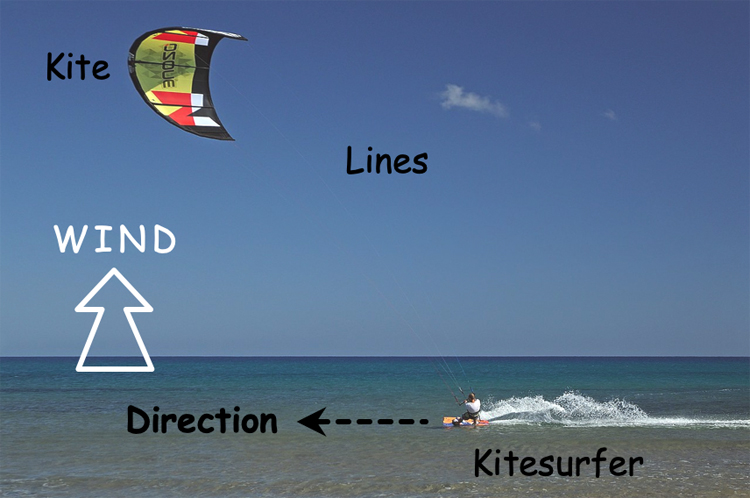
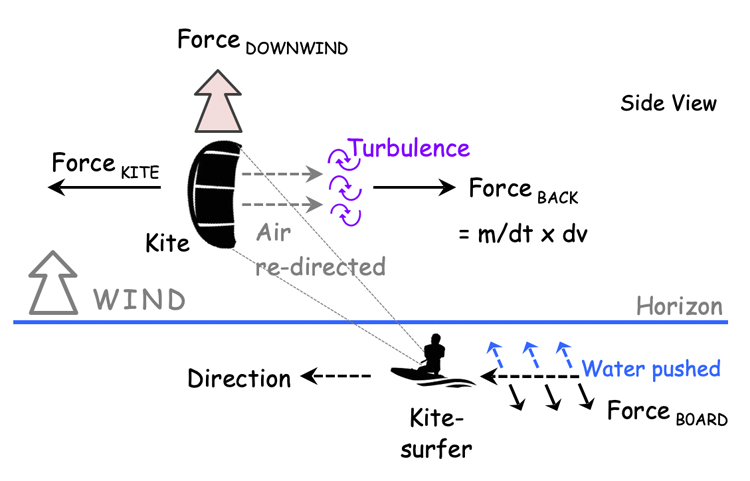
Where:
m = Mass of fluid (water or air)
m/dt = Mass flow rate
dt = Change in time (per second)
dv = Change in velocity (v)
v = Velocity
a = dv/dt = Acceleration
Force = ma = mxdv/dt = m/dt xdv
Force = ma = mxdv/dt=d(m/v)/dt
Momentum = mv
The physics described above is summarized by the equations:
Force BACK = ma = m/dt x dv (1)
Force BACK = Force Kite (2)
Then equations (1) and (2) can be combined as follows:
Force BACK = Force KITE = m/dt x dv
Or simply:
Force KITE = m/dt x dv (3)
Units:
N = kg/s x m/s
In these equations above, the change in velocity of the air is expressed as 'dv' and not as acceleration (dv/dt) because this action is due to a one-off force (impulse) from the kite or board, which is not time-dependent.
Whereas the mass of air passed through by the kite or board is time-dependent and, therefore, is expressed as the mass flow rate (m/dt).
The kite redirecting the apparent wind backward also creates a small downwind force directly against the kite.
To avoid being pushed downwind, the kiteboarder offsets this force by leaning into the wind and using the board to push water downwind towards the kite.
B. Examples
Examples of airflows and forces applied to kitesurfing are provided in the illustrations below.
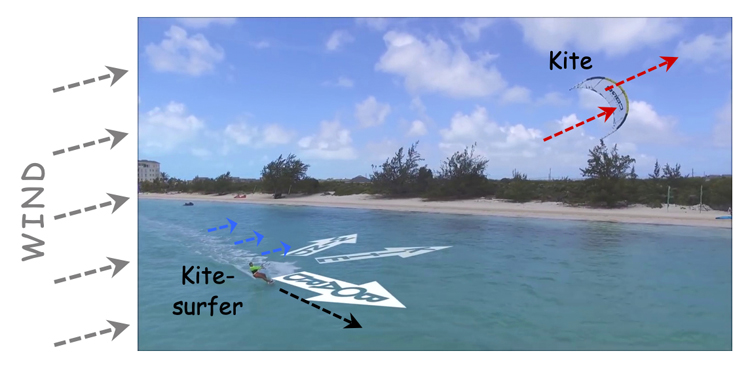
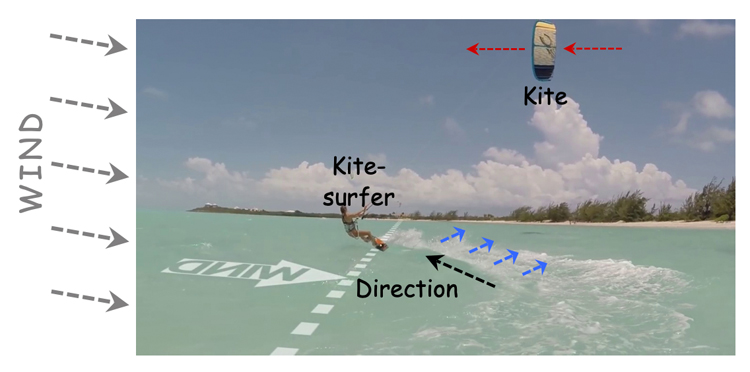
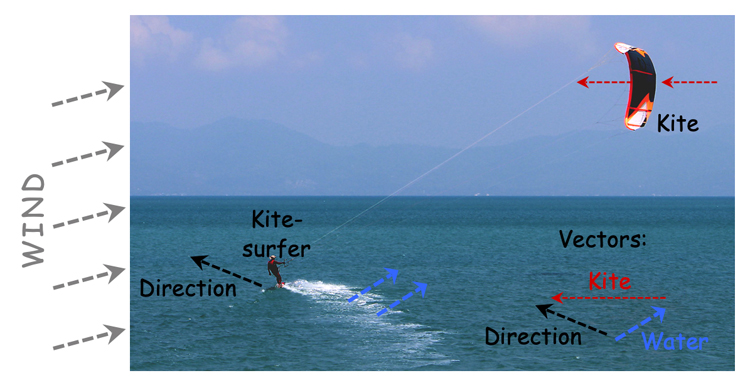
C. The Momentum Theory of Kiteboarding
There is no net gain or loss of momentum, energy, or mass in the process of kitesurfing.
The apparent wind has significant momentum (momentum = mass x velocity) and kinetic energy due to its mass and velocity.
Momentum and energy are transferred from the wind to the kiteboarder via the kite, by the kite slowing down the wind in two ways (see illustration below):
1) On direct contact with the kite, the wind slows down as it is redirected by the kite (from V1 to V2 in the illustration below)). This action creates a downwind force on the kite, which can be measured by the deceleration of the wind and the mass of the wind that is deflected by the kite. The downwind force does not contribute towards the forward force that pushes the kite ahead. The momentum transferred to the kite by the downwind force is relatively limited if the kite is flown efficiently;
2) The redirected apparent wind exits the kite and interacts with the undisturbed, apparent wind to create turbulence and the backward force.
The momentum transferred can be calculated based on the mass of the wind redirected and its deceleration (from V2 to V3 in the illustration below);
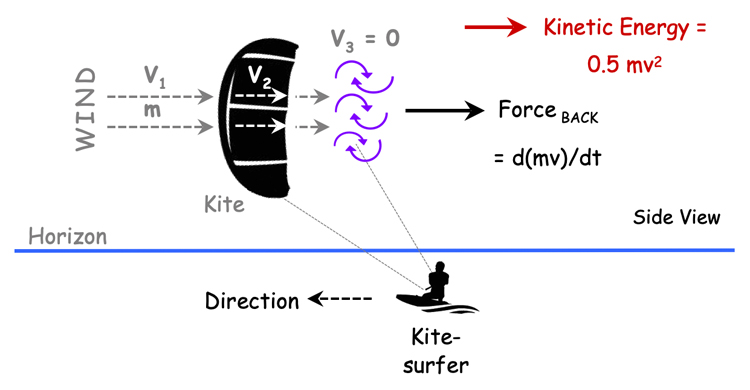
The transfer of momentum is expressed by the following equation:
Force BACK = ma = d(mv)/dt (7)
The forward and backward forces are equal, as described by equation (2), and therefore, equation (7) can be re-stated:
Force FORWARD = ma = d(mv)/dt (8)
D. The Two Newtonian Equations
The analysis above provides two Newtonian equations for the forward force generated by a kite:
Force FORWARD = ma = m/dt x dv (mass flow rate) (4)
Force FORWARD = ma = d(mv)/dt (momentum theory) (8)
Both equations (4) and (8) are based on Newton's Second Law of Motion (Force = ma).
Both equations are correct and produce the same values but express the same factors differently.
E. Analysis of 'm/dt'
The mass of air redirected each second (m/dt) by the kite can be broken down into air density and the competent parts that affect the volume of air redirected each second, which include kite speed, wingspan, and kite reach.
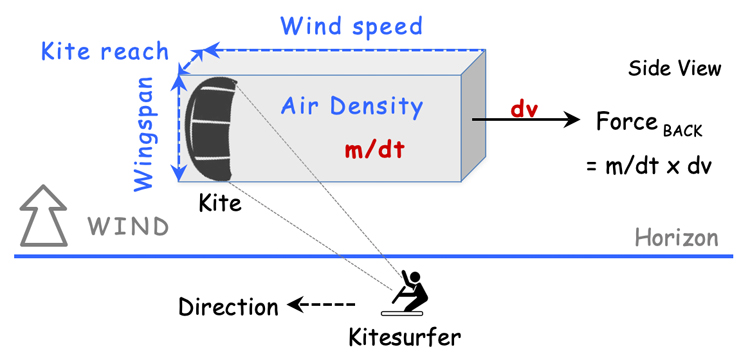
Kite reach is the distance away from the kite that the kite affects the airflow (apparent wind).
This feature depends partly on the thickness of the kite.
These relationships can be expressed by the equations:
m/dt = Volume/dt x Air Density
Volume/dt = Kite x length x Kite Reach x Apparent wind speed
F. Vector Analysis
The forces acting on a kitesurfer can be illustrated using vectors, as illustrated below.
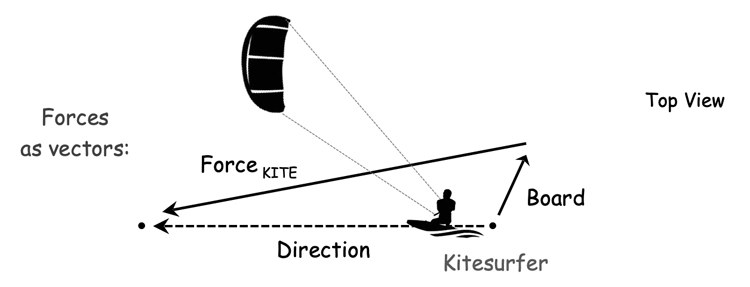
G. Power Window
The force generated by the kite (Force KITE) is typically described by a power window, which is greatest directly downwind of the kiteboarder and lowest to the ground (see illustration below).
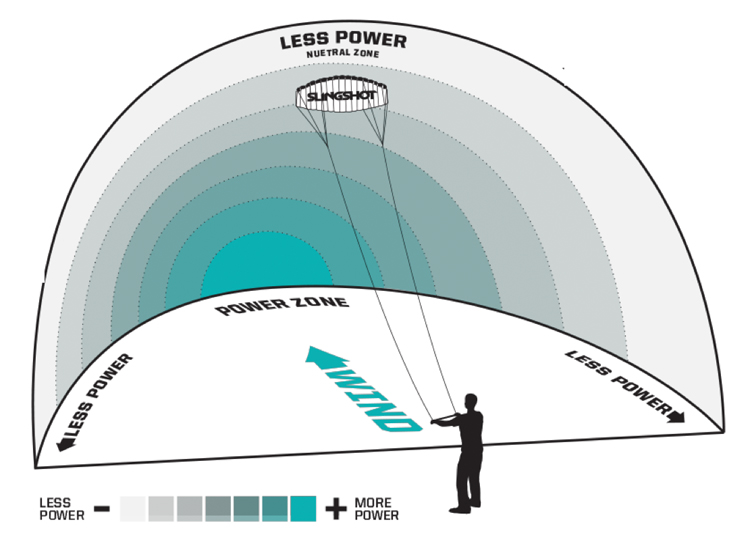
When the kite is dead downwind, at the point of maximum force generation from the perspective of the kitesurfer, the kitesurfer cannot travel upwind, only downwind.
This is because the kite is not generating any forward force to pull the kiteboarder upwind.
Force KITE Perceived by the Kitesurfer
The power window is not an entirely accurate description of the Force KITE.
It is just what the kiteboarder experiences or perceives.
Not all Force KITE is felt by the kitesurfer because some of it is used to counteract the force of the apparent wind against the kite.
The kiteboarder only feels the useful net Force KITE that is generated and available to the kitesurfer.
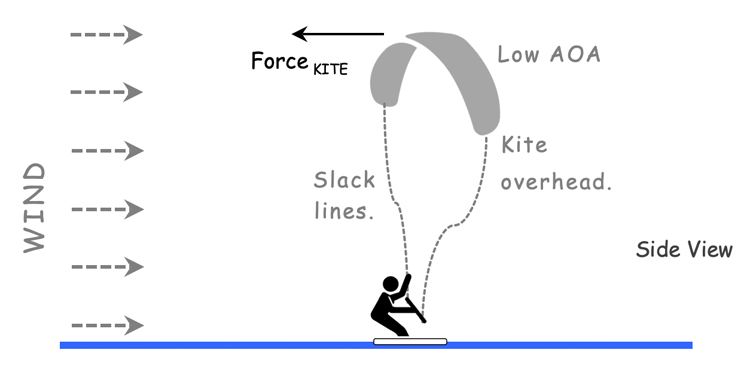
For example, if the kite is directly overhead of the kitesurfer, the kitesurfer experiences little power generated by the kite (low Force KITE).
However, the kite is generating a lot of force (high Force KITE) to maintain its position overhead and offset the force of the wind (see illustration above).
Parachute vs. Paraglider
The forces generated by a kite can be described separately between those generated by the inner side of the kite (parachute-type force) and the outer side of the kite (paraglider-type force).
At the maximum perceived power of the kite, directly downwind of the kiteboarder, the kite functions more like a parachute than a paraglider.
The kite AOA is at a maximum of 90°. The inside of the kite catches the maximum amount of wind possible.
However, there is no Coanda effect and no airflow over the leeward side of the kite over its outer side.
This paper also describes this force as the downwind force (Force DOWNWIND).
When the kite is dead downwind, the parachute component is at a maximum, and the paraglider component is at a minimum.
As the kite reduces its AOA and moves away from dead downwind, the situation reverses: the parachute component reduces, and the paraglider component increases.
The kite AOA decreases towards the lower power zones.
The kite functions increasingly less like a parachute and more like a paraglider.
The airflow decreases over the windward inner-side and increases over the leeward outer-side of the kite (due to the Coanda effect - see illustration below).
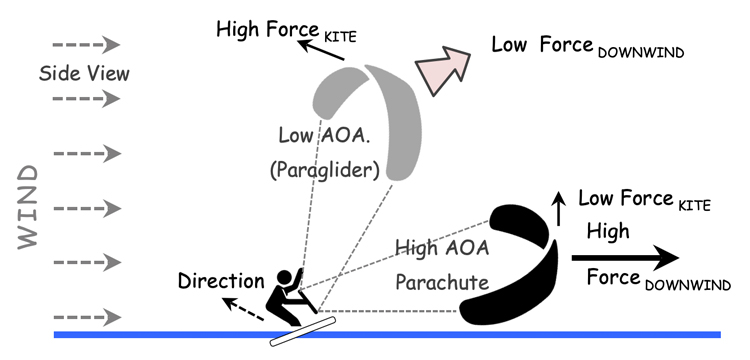
Factors Affecting the Force KITE Generated
The force generated by the kite (Force KITE) varies primarily with its AOA. The airflow redirected due to the Coanda effect on the leeward side of the kite is highly sensitive to the kite AOA.
This has a significant impact on the generated forces.
Force KITE also varies due to altitude, as wind speed tends to increase with altitude.
The paraglider component provides the ability to maneuver the kite sideways or upwards and, therefore, to adjust the amount and direction of the force generated by the kite's parachute component.
In high wind, the canopy can be aligned to produce a vertical force sufficient to pull the kitesurfer upwards.
There is also a trade-off between speed and the angle sailing upwind.
The closer the kiteboarder sails into the wind, the lower the power available to the kitesurfer and the slower the kitesurfer's speed.
The relationship between the kite AOA and speed is non-linear.
Beyond a certain kite AOA, the Force KITE available to the kitesurfer and the kitesurfer's speed decline disproportionately to any increase in kite AOA.
There is an optimum kite AOA that produces the highest speed for the kiteboarder into the wind.
H. Force From the Board
The process of the kite redirecting the wind also creates a small downwind force on the kite.
The kitesurfer opposes this force by leaning away from the kite and into the wind, as well as using the board to push water downwind.
This action maintains line tension, which allows the kiteboarder to control the kite, keeping it inflated and flying.
According to Newtonian mechanics based on the mass flow rate (Force = m/dt x dv), the force exerted by the board equals the mass of water each second (m WATER /dt), which is accelerated to a velocity (dv WATER) downwind.
The reaction is an equal and opposite force that pushes the kitesurfer into the wind (see illustration below).
This dynamic can be expressed by the equation:
Force BOARD = m WATER / dt x dv WATER
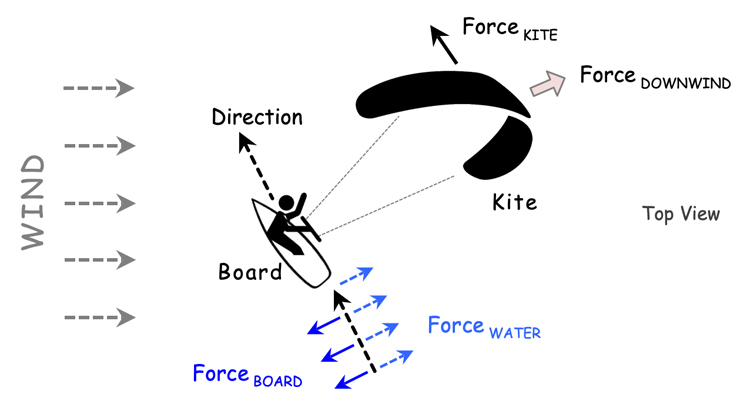
The direction of the force depends on the AOA of the board to the water. In turn, this dynamic can be used to control the board's direction.
In addition, in stronger wind, the kiteboarder must lean more into the wind to compensate for the force of the wind against their body.
I. Drag on the Board and Long Lines
The board experiences drag from the water, resisting its path forward. However, the kite does not experience this drag.
This means the kite advances forward faster than the kitesurfer. The kitesurfer also acts as a pivot to the kite.
Therefore, the kite eventually swings ahead of the kiteboarder.
In turn, this reduces the kite's AOA to the wind and, therefore, changes the direction of the generated force.
For example, if a kite is moving at 10 m/s (about 36 km/hr) and the kitesurfer is moving at a slower speed of 8 m/s due to drag from the water.
Then, the kite eventually swings in front of the kiteboarder (see illustration below).
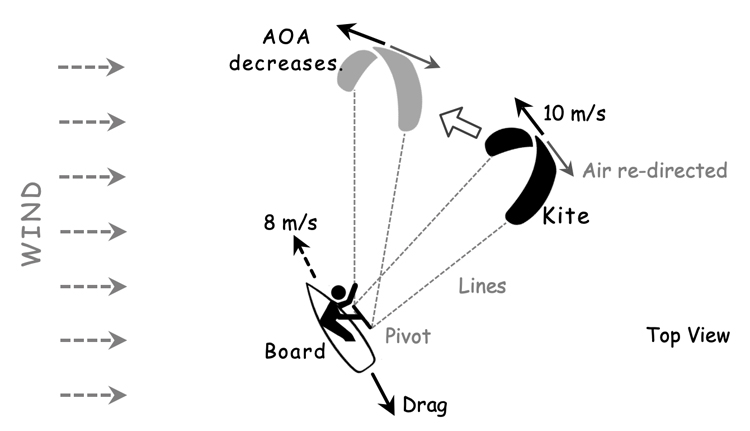
Long kite lines can partially offset this problem by reducing the angular speed at which the kite swings in front of the kitesurfer (see illustration below).
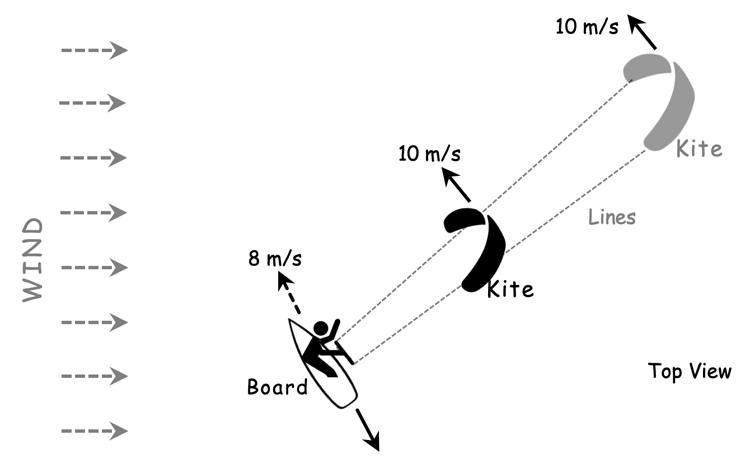
J. Additional Considerations
Other considerations include the following:
a) A bigger kite catches a greater mass of air from the wind each second (bigger m/dt), and, therefore, generates a bigger force from the kite (Force KITE);
b) A stronger wind blows a greater mass of air each second (bigger m/dt) against the kite at a higher velocity (bigger dv), and, therefore, generates a bigger Force KITE;
c) Different kite shapes and designs produce different airflows (aerodynamics). This creates different 'm/dt' and 'dv,' and, therefore, a different strength of the resultant Force KITE;
d) The direction and strength of Force KITE depend on the AOA of the kite to the wind, as described by the power window below. The entire leading edge of the kite can redirect the wind to generate a force from one wingtip to the other;
e) The kite's horizontal or vertical orientation does not affect the generated force. The force generated by a kite is symmetrical in all directions, as shown by the power window above;
f) Similar to gliders, kites have high aspect ratios with a long wingspan facing the wind;
g) The transfer of kinetic energy from the wind to the kite by sailing is expressed by the following equation: Kinetic Energy = 0.5 mv2;
h) The parameters to calculate the generated forward force while kiteboarding are consistent with those used to calculate the momentum and kinetic energy involved. This is not the case for the forces generated by kitesurfing based on fluid mechanics;
i) A kite acts in a manner that is similar to a big propeller that pushes air backward on an airboat (see illustration below);
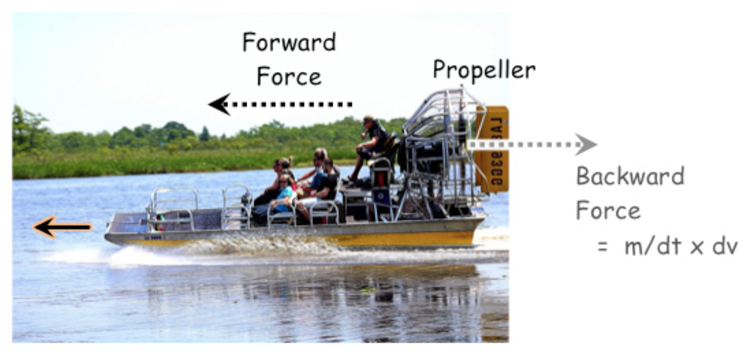
The comparison between a kite and an airboat is only illustrated by the principles of Newtonian mechanics involved.
The airboat's propeller accelerates a mass of air backward to create a force (Force = ma).
The reaction is an equal and opposite forward force.
A kite redirects the apparent wind to create a force like that of an airboat.
Both push air backward against the atmosphere to create turbulence and, therefore, a forward force.
This is the extent of the comparison being made.
K. Newtonian Mechanics is Universal
Newtonian physics is well established.
However, applying Newtonian mechanics to kiteboarding based on the mass flow rate is a new approach to understanding the physics of the sport.
The principles of Newtonian mechanics are universal.
For comparison, the thrust (Thrust = m/dt x dv) generated by a jet pack can also be calculated based on the mass of water each second (m/dt) accelerated downward to a velocity (dv) relative to the person (see illustration below).
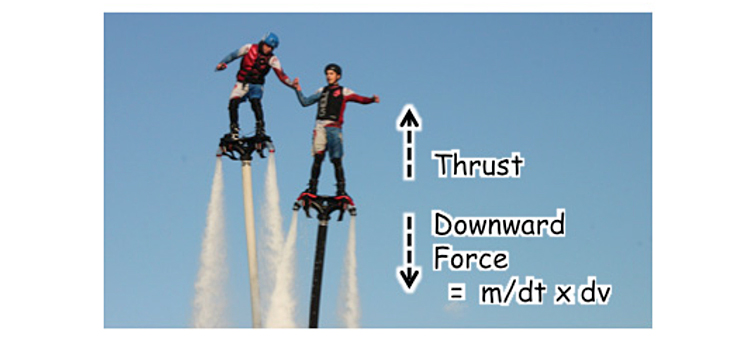
Similar to kites, a paraglider or glider slope soaring from the top of a hill generates a forward force by redirecting a rising headwind.
This force provides forward airspeed and lift (see illustration below).
However, kitesurfing is very different from an airplane or glider wing that generates vertical lift by pushing air downward.
In this case, momentum is transferred from the aircraft to the air to generate lift.
A kite's primary function is to generate a forward force, not a vertical lift.
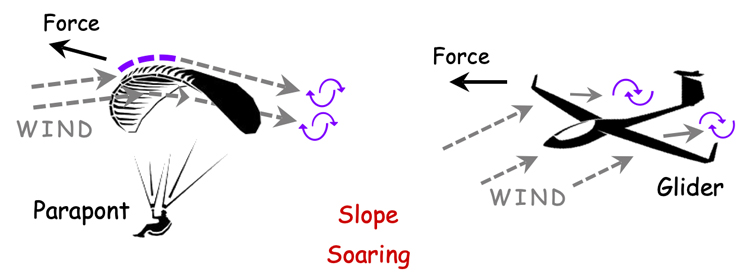
There are numerous examples of gliders soaring, which include the glider gaining altitude and airspeed while flying directly into the wind (see illustration below).

L. Other Explanations of How Kites Fly
Airbus
Airbus's website contains a video called "How Do Airplanes Fly."
The video claims that wings and standard kites (not kiteboarding kites) are similar and fly "by a gap above the wing sucking the wing up." (see illustration below)

Specifically, the video states, "The kite (wing) is not pushed up; it is sucked up. This is called lift. An airplane does exactly the same with its wings."
This statement is absurd and false as kites fly with a much higher AOA than airplane wings, so the two objects are not directly comparable.
A standard kite is pushed up by the wind; it is not sucked upward.
In addition, none of the key points on lift claimed by the Airbus video are supported by experimental evidence.

NASA
In contrast, NASA claims kites are pushed upwards according to Newtonian mechanics.
"When the wind hits the front of the kite, the wind is deflected downward, and there is a force in the opposite direction, which pushes the kite upward. This action depicts Newton's Third Law of Motion (...)."
5. Example Calculation
A. Overview
An example calculation of the forward force generated by a kite according to Newtonian mechanics based on the mass flow rate is provided below.
This example is an approximation and is for illustration purposes only.
It is intended to demonstrate how Newtonian mechanics can be applied in practice. It is not meant to be precisely accurate or overly realistic.
B. Key Assumptions
Key data assumptions include (see illustrations below).
a) Standard air density is 1.2 kg/m3;
b) Apparent wind speed is 10 m/s (about 36 km/hr). It is redirected by the kite at an average velocity (dv) of 8 m/s (about 29 km/hr). The decline velocity is the force lost to pushing the kite downwind (Force DOWNWIND);
c) The length of the kite's leading edge is 12 meters;
d) Kite reach is 0.25 meters (25 cm) on either side of the kite (0.5 meters total);
e) Kite reach is the distance away from the kite that the kite affects the airflow (apparent wind), which partly depends on the thickness of the kite;
For simplicity, several situational assumptions are made:
a) The kite is sailing at a constant velocity into a laminar, constant-velocity wind;
b) The airflows are even across the kite;
c) Vortices or wind shear are not significant;
d) The kite width is not considered to be directly relevant to this calculation. It is indirectly important, as it affects the kite reach and the 'dv' that is assumed;
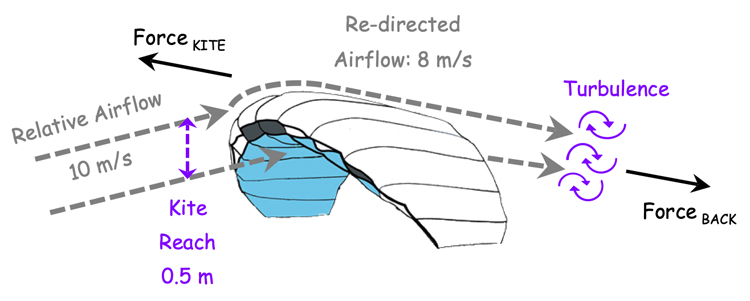
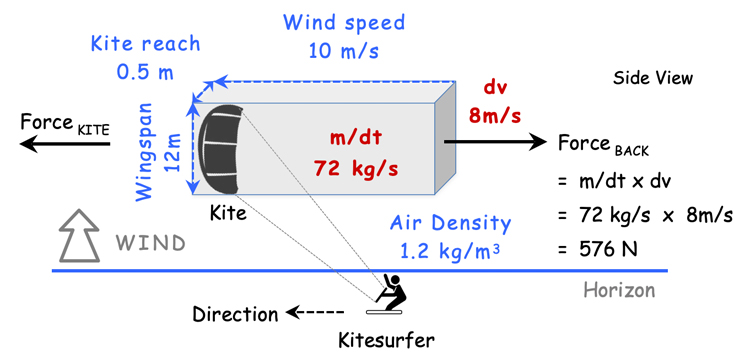
C. Example Calculation - Methodology
1) The volume of air displaced by the kite each second (Volume/dt) is estimated to be 60 m3/s based on the kite length, kite reach, and apparent wind speed;
Volume/dt = Kite x Kite Reach x Apparent wind speed
60m3/s = 12m x 0.5m x 10m/s
A 12-meter long kite with a 0.5 m kite reach, in a 10 m/s (36 km/hr), apparent wind displaces 60 m3/s of air each second;
2) The mass of air displaced each second (m/dt) by the kite is calculated to be 72 kg/s based on the volume of air displaced each second and the standard air density of 1.2 kg/m3;
m/dt = Volume/dt x Air Density
72 kg/s = 60 m3/s x 1.2 kg/m3
3) Using the assumed 'dv' of 8 m/s, the backward force is calculated by multiplying 'm/dt' by 'dv.'
Backward Force = m/dt x dv
= 72kg/s x 8m/s
= 576 kg m/s2
= 576N
= Force KITE
The kite redirects 72 kg/s of air at 8 m/s, which interacts with the undisturbed airflow from the apparent wind to create turbulence and a backward force of 576 N.
The equal and opposite forward force of 576 N (Force KITE) pushes the kite ahead.
D. Comment
The force calculated above is more than sufficient to pull a person out of the water and accelerate the individual to a fast speed.
According to Newtonian mechanics, a 576 N force can accelerate an 80 kg person at 7.2 m/s, as shown by the calculation:
Force = mass x acceleration 576N = 80kg x 7.2m/s2
The simplicity of this example shows the straightforward approach of the Newtonian calculations involved.
Other theories of sailing, such as fluid mechanics, fail to provide such simple and understandable calculations based on realistic conditions.
The key parameters that are the most difficult to estimate in practice are the 'kite reach' and 'dv.'
6. Comparison to Sailing
A. Newtonian Mechanics Explains Sailing
The generated forward force depends primarily on the amount and speed of air redirected by the sail.
Boats sailing into the wind on a close haul tack at a positive sail angle-of-attack (AOA) redirect a moving mass of air each second (m/dt) from the apparent wind backward at a velocity relative to the boat (dv), which is helped by the Coanda effect on the leeward side.
As the redirected air pushes against the undisturbed air from the apparent wind, causing turbulence, this action creates a backward force (Force = ma = m/dt x dv).
The reaction generates an equal and opposite forward force that pushes the boat ahead (see illustrations below).
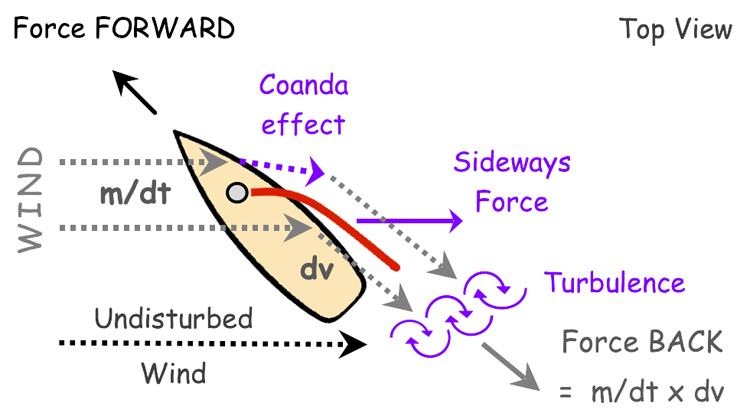
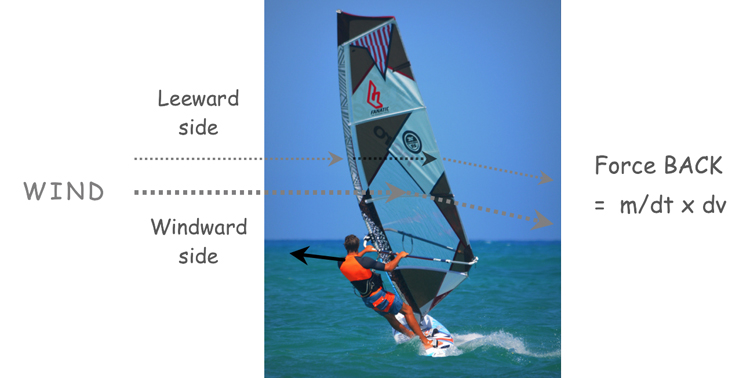
No other theory of sailing, such as fluid mechanics, provides such a straightforward explanation of the physics of sailing.
When sailing into the wind, the airflow is redirected due to the Coanda effect on the leeward side of the sail, which is highly sensitive to the sail AOA.
This has a significant impact on the generated forces (see illustrations below).

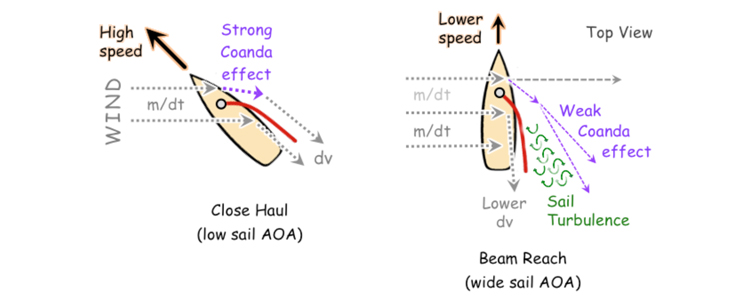
A positive feedback loop arises as the boat sails closer into the wind.
As the boat's speed increases while sailing into the wind, this causes an increase in the 'm/dt' and 'dv' of the apparent wind.
Therefore the forward force generated (Force = m/dt x dv) increases.
In turn, this causes the boat's speed to increase further.
B. Comparison of Sailing and Kiteboarding
The underlying physics of sailing and kitesurfing are similar; both can be described by Newtonian mechanics based on the mass flow rate (Force = m/dt x dv) created by a redirected airflow.
A difference between sailing and kiteboarding is that a kite surfer leans their body into the wind and pushes water downwind to counteract the downwind force on the kite.
In contrast, a boat sailing into the wind opposes the downwind force on the sail by tilting with the wind and the keel opposing the tilting.
A sailboat is not observed to push water downwind away from its hull or keel as the kitesurfer does.
This difference arises because a sailboat uses a rudder to steer, whereas a kiteboarder uses its board to steer, which makes it a lot more maneuverable (see illustrations below).
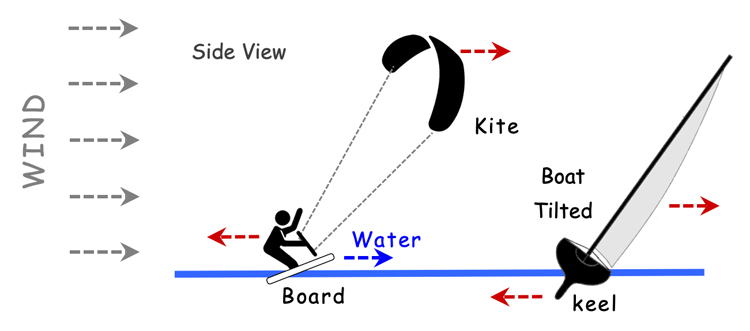

7. Discussion of Results
Kitesurfing can be seen as wakeboarding with a paraglider or windsurfing with a short board and a detached sail.
The kite has a design, shape, and function similar to a paraglider.
The airflows and resultant forces are almost identical. In addition, the basic function of a kite is similar to a sail.
Better kiteboarding styles and equipment can be obtained by analyzing how 'm/dt' and 'dv' are affected by any changes or alternatives and, therefore, the force generated by the kite (Force = m/dt x dv).
8. Conclusions
Newtonian mechanics based on the mass-flow rate (Force = m/dt x dv) provides a simple explanation for kitesurfing, which is consistent with what is observed in practice and accepted physics.
It is puzzling that no one has presented this approach previously.
Words by Nicholas Landell-Mills
